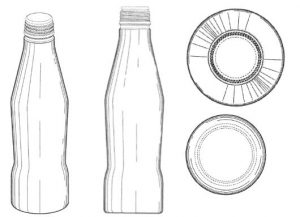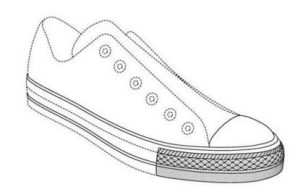
On October 30, 2018, the United States Court of Appeals for the Federal Circuit vacated and remanded the International Trade Commission’s decision regarding the trade dress infringement of Converse’s design in its Chuck Taylor shoes (see below). In a split opinion, the Court held that trade dress infringement occurs only if the defendant’s design is substantially similar to the plaintiff’s design – a standard which the Federal Circuit noted was analogous to the standard for design patent infringement: “where infringement cannot be found unless an ordinary observer would perceive that the ‘two designs are substantially the same.’”
Given the tie the Federal Circuit made between trade dress and design patent infringement, it would be beneficial to discuss the similarities and differences between the two in more detail, especially when the two overlap in product design.
Design Patent
Design patents protect novel ornamental features of an article of manufacture, and not its utilitarian characteristics. They cover the visual, nonfunctional features in the product, extending to the shape of the product, a surface ornamentation, or the combination of both. Design patent protection extends only to the appearance of the product, and not its functionality. If the design is necessary for the product to operate or work, it is considered functional, and therefore ineligible for protection.

The drawings of a design patent define the metes and bounds of the ornamental design. For example, referring to the bottle design shown above, the solid lines are essential features that are claimed as part of the design; the dotted lines are elements that are present in the design, but are not claimed. Last, design patents have a term of 15 years from the date of grant; afterwards, the design claimed enters into the public domain.
Trade Dress
Trade dress is a type of trademark. As with all forms of trademark, trade dress is used to identify a source of a good and/or service, as well as the goodwill associated with that source. Trade dress refers to the overall appearance and image of a product. Examples of trade dress include the look and feel of a restaurant or retail store, packaging for a product, and a product’s design.
When pursuing a registration for trade dress, drawings, like those used for design patents, can be submitted, with a description of the trade dress, as shown below:

Converse’s trade dress registration (No. 4,398,753) covered the above, including the following description: The mark consists of the design of the two stripes on the midsole of the shoe, the design of the toe cap, the design of the multi-layered toe bumper featuring diamonds and line patterns, and the relative position of these elements to each other. The broken lines show the position of the mark and are not claimed as part of the mark.
In order for a product design to be registerable as trade dress, the design must (1) be used in commerce; (2) serve to identify the source of the product; (3) be primarily nonfunctional; and (4) be distinctive in the marketplace. Product design can never be inherently distinctive; distinctiveness must be obtained through acquiring secondary meaning (i.e., consumers associate the design with the source of the product), which occurs through exposure and advertising over time. At the U.S. Patent and Trademark Office, substantially exclusive and continuous use of a product design for five years is usually sufficient to show a design has acquired secondary meaning. Unlike design patents, the protections for trade dress can extend indefinitely as long as the standards above have been met and the use of the product design is continuous.
Additional Takeaways
Design patent and trade dress protection can be used on the same product design for overlapping periods of time. For example, when a new product design is developed, trade dress is not available as there is no way to establish that it has acquired secondary meaning. However, to protect the new design, a design patent can be filed. And while the design patent will eventually expire after 15 years, the design patent provides more than enough time for the product design to acquire the secondary meaning needed to become eligible for trade dress protection
While there is some overlap in the tests for infringement of trade dress and design patents, as alluded to by the Federal Court, that overlap is limited. Design patent infringement is found when a defendant’s design is substantially similar to the design as claimed through the perception of an ordinary observer. This analysis focuses only on the claimed elements of the design patent. To prove trade dress infringement, the trade dress owner must show that consumers are likely to be confused to the source of the goods when comparing the product designs. While the similarity of the designs does play a part in the analysis, additional factors, such as the similarity of the goods, the level of sophistication of the consumers, and intent, are also considered. Further, unlike design patent infringement, which focuses only on the claimed elements (i.e., the solid lines), the overall appearance of the product in the marketplace (e.g., how the product is sold, additional trademarks and insignia placed on the product) is considered.
If you have a product design that has some value, the strategic use of design patents and trade dress can ensure your rights in that design are secured. Please contact your IP counsel if there is any way that we can assist in obtaining protections in your product design.

